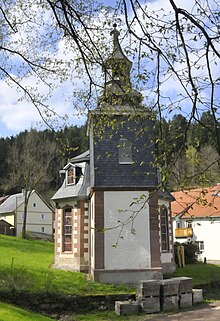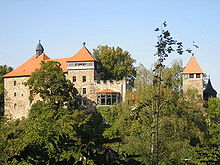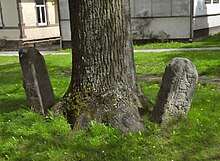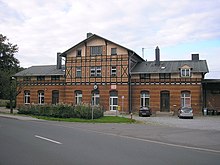Elgersburg
| coat of arms | Germany map | |
|---|---|---|

|
Coordinates: 50 ° 42 ' N , 10 ° 51' E |
|
| Basic data | ||
| State : | Thuringia | |
| County : | Ilm district | |
| Management Community : | Geratal / Plaue | |
| Height : | 490 m above sea level NHN | |
| Area : | 9.49 km 2 | |
| Residents: | 1249 (Dec. 31, 2019) | |
| Population density : | 132 inhabitants per km 2 | |
| Postal code : | 98716 | |
| Area code : | 03677 | |
| License plate : | IK, ARN, IL | |
| Community key : | 16 0 70 011 | |
| LOCODE : | DE EQG | |
| Address of the municipal administration: |
Lindenplatz 5 98716 Elgersburg |
|
| Website : | ||
| Mayor : | Mario Augner (independent) | |
| Location of the municipality of Elgersburg in the Ilm district | ||
Elgersburg is a municipality in the Ilm district in Thuringia in Germany .
geography
Elgersburg is located on the northern edge of the Thuringian Forest at an altitude of about 500 meters and at the same time on the northern edge of the nature reserve and the Thuringian Forest Nature Park. The place is in the north of the district area, which also includes large forest areas in the south up to the two meadows . The most striking mountains in the village are the 765 meter high Hohe Warte with the Carl Eduard Tower and the 799 meter high Rumpelsberg , the highest point in the community. Other nearby mountains in the Thuringian Forest are the 769 meter high Heidelberg, the 754 meter high Brunschildskopf, the 771 meter high Himmelreichskopf and the 784 meter high Leimbühl.
The historic Salzmannstrasse , on which the Mönchhof , a popular excursion restaurant, is located , leads from Elgersburg to Schmücke am Rennsteig . Other hiking destinations in the municipal area are the Schöffenhaus , the Emmafelsen, the Wolfsstein and the Marienquelle and the Sophienquelle. In the Körnbachtal above Elgersburg you can find the Piuttifels and the Goethefelsen as well as the castle and clementine springs.
Elgersburg Castle is located on a porphyry rock in the village. To the northeast in the foreland of the Thuringian Forest lies the 549 meter high Hirtenberg and to the northwest between Elgersburg and Geraberg the Mönchsheide.
There are essentially three valleys in the area: the Körnbachtal in the west between Hoher Warte and Geraberg, the Steigerthal in the middle, starting at the Sophienquelle, which also runs through the village and leaves it in the direction of Reichenbachtal to Martinroda and the Reichenbachtal itself in the east from Elgersburg. It leads to Ilmenau-Roda up the valley or Martinroda down the valley.
The municipality of Elgersburg is largely forested, with the spruce being the predominant tree species. Only north of the village are there a few meadows that are used for grazing.
Neighboring communities
Clockwise, starting in the north: Martinroda , Ilmenau , Suhl , Geratal
history

The place was first mentioned in 1139 as Adelgeresburg . The castle and town belonged initially to the Lords of Elgersburg, then fell to the Counts of Kevernburg . In 1288 they were acquired by the Counts of Henneberg -Schleusingen, before the place was pledged to Landgraves Friedrich, Balthasar and Wilhelm von Thuringia in 1365 and came under the sovereignty of the Wettins. In 1437 the gentlemen von Witzleben bought Elgersburg, who now owned it until 1802. In 1540 the Counts of Henneberg ceded the last claims to Elgersburg to the Ernestine House of Saxony. From 1640 it belonged to Saxe-Gotha (from 1672-Altenburg, from 1826 Saxe-Coburg and Gotha), which exercised full state sovereignty from 1670. In 1802 the Ducal Chamber of Gotha bought the Elgersburg castle and estate from the Lords of Witzleben.
On May 28, 1837, Germany's first cold water healing facility opened in Elgersburg . This establishment, run according to the Prießnitzschem spa principle , was founded by the farmer Jacob Gräser with the assistance of the businessman Schmidt. The first medical director was Dr. phil. Adolph Martini, who was appointed to the newly established cold water sanatorium in Bad Liebenstein as early as 1840. His successor as bathing director was the medical council Dr. med. Hermann Piutti (1812-1865). This began the development of a health resort , which brought the village the name Bad Elgersburg in 1837 . It is thanks to Piutti's wife, Maria Piutti (1818–1868), that the bathing resort received its first infant care facility. The Marienquelle , which lies on the Goethe hiking trail Ilmenau – Stützerbach, was named in her honor .
After the Elgersburg courts were repealed, Elgersburg and the associated towns of Manebach , Geraberg , Neuroda and Traßdorf were incorporated into the Liebenstein Justice Office, which was founded in 1830 and which became part of the Ohrdruf district administration with the administrative reform in the Duchy of Saxony-Coburg and Gotha in 1858 . Ernst II loved to come to Elgersburg to hunt or relax. It is also thanks to Ernst II that Elgersburg got a railway connection in 1879. Originally the railway line was supposed to pass Elgersburg approx. 2 km east, but the duke insisted that the place be connected to the line. The route was rescheduled again and a train station for Elgersburg was guaranteed. When the station was built, a fish pond in the area of today's platforms had to be filled. Many of the workers involved died from an epidemic that was attributed to the pond. In 1905 and 1906 the expressionist painter Edvard Munch stayed in Elgersburg. From 1922 the place belonged to the district of Arnstadt .
The children's home of the Red Aid , which opened in 1925, was expropriated by the National Socialist authorities in 1933, as a memorial plaque on the site, which is now used as a hotel and educational facility for the party Die Linke . (See also the children's home of the Red Aid ).
The district was divided in 1952, and Elgersburg was henceforth part of the Ilmenau district . In 1994 the Ilmenau and Arnstadt districts were reunited under the name Ilm District.
church
Elgersburg Castle

Elgersburg is best known for its castle of the same name, which dates back to 1088. It was built on the walls of a castle of the Counts of Kevernburg and the Lords of Witzleben, which served to protect Salzmannstrasse . It was built as a protective and stronghold on a porphyry rock above the place by Gerhard Edler von Grumbach, also called Edler Gerhard or Elger, to which the name of the place refers. 1156 a Markward von Elgersburg was named. In 1288 it was sold to the county of Henneberg for 400 silver marks . It then belonged to Henneberg from 1288 to 1297, Witzleben from 1297 to 1316 , Henneberg from 1316 to 1347, Gleichen from 1347 to 1365 and from 1365 to 1437 of the Landgraviate of Thuringia . From 1437 to 1802 it was again owned by the Witzleben family. In 1802 the castle (together with the villages of Elgersburg, Neuroda , Geraberg , Manebach (western part) and Traßdorf ) was acquired for 126,000 thalers by the Duchy of Saxe-Gotha-Altenburg and the ducal government. In 1905 the Elgersburg was expanded into a palace by Duke Carl Eduard . The castle, reopened in 1998, has been owned by the Elgersburg community since then. The castle, which was never conquered, is still in good condition thanks to numerous renovations.
Population development
Development of the population:
|
Data source: from 1994 Thuringian State Office for Statistics - values from December 31st
politics
Elgersburg is a politically independent municipality, which is part of the Geratal / Plaue administrative community .
Municipal council
The council of the Elgersburg community consists of 12 councilors. Since the municipal council election on May 26, 2019 , it has the following composition:
| • Elgersburg citizens' initiative - open list: | 5 seats (45.7% of the votes) |
| • CDU : | 5 seats (41.2% of the votes) |
| • Elgersburg open list: | 2 seats (share of votes 13.0%) |
mayor
In the mayor election on June 5, 2016, Mario Augner was elected honorary mayor. Before that, Ingolf Schwarze (initially a citizen for Elgersburg, later CDU) had been in office since 1994.
coat of arms
The coat of arms was approved on March 25, 1994.
Blazon : "In green under a silver wedge, inside a blue lintel rafters, on a corrugated blue shield base, inside a silver wavy band, a silver castle with a closed gate."
The stylized silver castle is supposed to symbolize the place name as an eloquent coat of arms. For centuries the lords of the Elgersburg were the lords of Witzleben. The lintel rafters are borrowed from the coat of arms of this family and instead of the original tinging silver and red are covered with the Elgersburg local colors. The blue base of the shield with the silver wave bar refers to the importance of Elgersburg as a health resort and recreation area. One of the first cold water healing institutions in Germany existed in Elgersburg.
Culture and sights
- Like other health resorts in the Thuringian Forest, Elgersburg was also visited by Goethe . In 1831, on his last visit, accompanied by his grandchildren, he signed the guest book of the Alte Massemühle.
- Fritz Reuter stayed in the village for several weeks in 1868 and 1869 and mentioned the art of water healing in his story Ut mine Stromtid (from my time as a volunteer).
- Elgersburg Castle is home to a restaurant, the Thuringian Heritage Association, an IT company, project workshops and the Geratal tourism agency . Weddings, castle tours, changing galleries and events in the knight's hall and on the stage make the castle a cultural center for the administrative community.
- The mass mill is a technical monument with completely contained machinery for the production of porcelain mass and laboratory porcelain. In 2007 the association Arbeitsgemeinschaft Massemühle e. V. founded and set itself the task of restoring the mass mill.
- Hohe Warte observation tower
- Hotel "Am Wald": The building used to be a. a children's home and is now a conference hotel. (See main article → Hotel am Wald (Elgersburg) )
- Two of the four rediscovered Mönchssteine , former boundary stones , stand on Lindenplatz .
- Hohe Warte, Schöffenhaus and Mönchhof are forest restaurants and excursion destinations in the Thuringian Forest
Economy and Transport
Elgersburg was a health resort for a long time, so there was relatively little industry. Before 1990 there were a few factories that manufactured thermometers . There were also companies that manufactured or processed porcelain . Until the beginning of the 20th century, there was also manganese mining in Elgersburg . Today there are small industrial areas with various medium-sized companies in the north and west of the town. Many people from Elgersburg commute to work in Ilmenau, 5 km away.
Elgersburg is on the Erfurt – Ilmenau railway line and on the former B88 that connects it with Ilmenau and Gotha . There is also a road to Geraberg .
Personalities
- Christian Heinrich Rinck (born February 18, 1770 in Elgersburg, † August 7, 1846 in Darmstadt), German Biedermeier composer
- Ernst II (born June 21, 1818 in Coburg, † August 22, 1893 in Reinhardsbrunn near Gotha), Duke of Saxe-Coburg and Gotha, Elgersburg was his "favorite vacation spot", which is why he stayed there very often
- Karl Piutti (born April 30, 1846 in Elgersburg, † June 17, 1902 in Leipzig), German composer
- Edvard Munch (* December 12, 1863 in Løten, Hedmark, Norway; † January 23, 1944 at Ekely in Oslo), Norwegian painter and graphic artist ( The Scream ), stay at Elgersburg from November 1905 to March 1906
- Werner Gimm (1917–1977), German geotechnician
- Gertraud Heise (* 1944 in Elgersburg), German journalist and author
- Bernhard Wabnitz (born March 14, 1952 in Elgersburg), journalist, from 1999 to 2006 first editor-in-chief of ARD-aktuell
- Rainer König (born June 3, 1958 in Elgersburg), traffic scientist and university professor
- Uwe Handrich (born April 26, 1959 in Elgersburg), German luge, European champion 1982
- Ralf Kowalsky (born March 22, 1962 in Elgersburg; † November 14, 1990 near Chemnitz), athlete
- Inés Brock (born September 30, 1964 in Elgersburg), German politician (Alliance 90 / The Greens)
- Mario Röser (born December 23, 1966 in Elgersburg), football player
- Olaf Kießling (* 1967 in Elgersburg), politician (AfD)
Individual evidence
- ^ Population of the municipalities from the Thuringian State Office for Statistics ( help on this ).
- ↑ Thuringian Association of the Persecuted of the Nazi Regime - Association of Antifascists and Study Group of German Resistance 1933-1945 (ed.): Heimatgeschichtlicher Wegweiser to places of resistance and persecution 1933-1945, series: Heimatgeschichtliche Wegweiser Volume 8 Thüringen, Erfurt 2003, p. 139 , ISBN 3-88864-343-0
- ↑ Michael Köhler: Thuringian castles and fortified prehistoric and early historical living spaces. Jenzig-Verlag, 2001, ISBN 3-910141-43-9 , p. 93.
- ↑ a b c Ulrich Völkel: Gastliches Thüringen. Arnstadt 1993, ISBN 3-929662-00-0 .
- ^ Source for Schwarzburgische and Saxon places: Johann Friedrich Kratzsch : Lexicon of all localities of the German federal states . Naumburg, 1843. Available online from Google Books . Source for Prussian places: Handbook of the Province of Saxony. Magdeburg, 1843. Available online at Google Books
- ^ Michael Rademacher: German administrative history from the unification of the empire in 1871 to the reunification in 1990. Population figures. (Online material for the dissertation, Osnabrück 2006).
- ↑ Population development since 1989 (TLUG) ( Memento of the original from October 29, 2012 in the Internet Archive ) Info: The archive link has been inserted automatically and has not yet been checked. Please check the original and archive link according to the instructions and then remove this notice. (PDF; 18 kB)
- ^ Thuringian State Office for Statistics - 2019 municipal council elections in Thuringia, final result: Elgersburg
- ↑ Mayoral elections in Thuringia, Elgersburg municipality. Thuringian State Office for Statistics, accessed on June 29, 2019 .
- ^ New Thuringian Wappenbuch Volume 2, page 9; Publisher: Arbeitsgemeinschaft Thüringen eV 1998 ISBN 3-9804487-2-X
literature
- Emil Osann: Hydrology with a special relationship to the water healing institutions in Ilmenau and Elgerburg in the Thuringian Forest . Berlin 1839
- Andreas Heinrich August Hatham: Elgersburg castle and village at the foot of the Thuringian Forest with its hydrotherapy institute and the immediate vicinity . Arnstadt / Elgersburg 1841 ( Google Books )
- August Beck: History of the Gothic country towns, market towns and villages . Part I, Gotha 1875
- Alexander Marc: Bad Elgersburg Cold Water Sanatorium in Thuringia . Wiesbaden 1876 ( digitized version )
- Woerl's travel manuals: guides through Bad Elgersburg . Würzburg and Vienna 1888
- Oskar Valerius Barwinski: Bad Elgersburg in the Thuringian Forest with its immediate and wider surroundings . 8th edition, Gotha 1892
- Dr. Paul Wiedeburg: Chronicle of Elgersburg Castle and Place . Gotha 1901
- Arnold Boie: Contributions to the building history of the Elgersburg . In: Communications of the Association for Gotha History and Antiquity Research (1909/10) p. 1-20
- Fritz Liebeskind: The Elgersburg in the Thuringian Forest . 1926
- Reinhard Döring: The Elgersburger Promenaden. On the trail of old memorials, springs and wells . Ilmenau 2017









